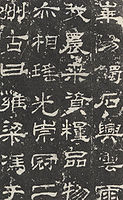
Clerical script
Encyclopedia

Chancery hand
The term "chancery hand" can refer to one of two very different styles of historical handwriting.A chancery hand was at first a form of handwriting for business transactions that developed in the Lateran chancelry of the thirteenth century, then spread to France, notably through the Avignon...
script, is an archaic style of Chinese calligraphy which evolved in the Warring States period
Warring States Period
The Warring States Period , also known as the Era of Warring States, or the Warring Kingdoms period, covers the Iron Age period from about 475 BC to the reunification of China under the Qin Dynasty in 221 BC...
to the Qin dynasty
Qin Dynasty
The Qin Dynasty was the first imperial dynasty of China, lasting from 221 to 207 BC. The Qin state derived its name from its heartland of Qin, in modern-day Shaanxi. The strength of the Qin state was greatly increased by the legalist reforms of Shang Yang in the 4th century BC, during the Warring...
, was dominant in the Han dynasty
Han Dynasty
The Han Dynasty was the second imperial dynasty of China, preceded by the Qin Dynasty and succeeded by the Three Kingdoms . It was founded by the rebel leader Liu Bang, known posthumously as Emperor Gaozu of Han. It was briefly interrupted by the Xin Dynasty of the former regent Wang Mang...
, and remained in use through the Wèi
Cao Wei
Cao Wei was one of the states that competed for control of China during the Three Kingdoms period. With the capital at Luoyang, the state was established by Cao Pi in 220, based upon the foundations that his father Cao Cao laid...
-Jìn (晉) periods. Due to its high legibility to modern readers, it is still used for artistic flavor in a variety of functional applications such as headlines, signboards, and advertisements. This legibility stems from the highly rectilinear structure, a feature shared with modern regular script (kaishu)
Regular script
Regular script , also called 正楷 , 真書 , 楷体 and 正書 , is the newest of the Chinese script styles Regular script , also called 正楷 , 真書 (zhēnshū), 楷体 (kǎitǐ) and 正書 (zhèngshū), is the newest of the Chinese script styles Regular script , also called 正楷 , 真書 (zhēnshū), 楷体 (kǎitǐ) and 正書 (zhèngshū), is...
. In structure and rectilinearity, it is generally similar to the modern script; however, in contrast with the tall to square modern script, it tends to be square to wide, and often has a pronounced, wavelike flaring of isolated major strokes, especially a dominant rightward or downward diagonal stroke. Some structures are also archaic.
Origins
Clerical script is popularly but mistakenly thought to have developed or been invented in the early Hàn dynastyHan
-China:* China , an abbreviation or adjectival modifier for things Chinese* Han Chinese , the dominant majority ethnic group of China and overseas Chinese...
from the small seal script. There are also historical traditions dating to the Hàn dynasty which mistakenly attributed the creation of clerical script to the Qín dynasty and in particular to Chéng Miǎo, who was said to have invented it at the behest of Qín Shĭhuáng. Another traditional account is that it was invented by government scribes, in particular those involved in the justice and penal systems. However, from written materials unearthed by archaeologists, it is now known that all stages of Chinese writing underwent periods of natural evolution, and none of them were inventions by one person; this is true of clerical script as well. Furthermore, rather than being established by government scribes, it has been argued that clerical script was already in popular use, and the Qín dynasty use by scribes merely reflects this trend. Archaeological discoveries now clearly show that an immature form of clerical script ("proto-clerical") was already developing in the state of Qín during the Warring States period, and into the early Western Hàn; this can be seen on a number of bamboo books unearthed recently. Furthermore, the writing immediately preceding clerical script was not merely seal script; rather, there was a coexistence of seal script (the at-first dominant and formal style) alongside an increasingly popular but secondary form of "vulgar", "popular", or "common" writing which was very roughly executed and which was generally rectilinear. The popularity of this vulgar writing grew as the use of writing itself became more widespread. The structures and style of many of the characters executed in this vulgar writing were similar or even identical to their later clerical script counterparts, leading some to conclude that proto-clerical (and therefore clerical) script evolved not from seal script but from the vulgar writing of Qín which coexisted with seal script in Warring States to Qín dynasty. The Qín bamboo script is a good example of this transition, having evolved from vulgar Qín writing and considered by some to constitute Qín clerical script.

